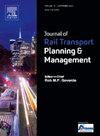Optimization method for maximizing capacity utilization of high-speed railway train timetable based on node routing model
IF 2.7
Q3 TRANSPORTATION
Journal of Rail Transport Planning & Management
Pub Date : 2025-09-10
DOI:10.1016/j.jrtpm.2025.100548
引用次数: 0
Abstract
The increasing passenger demand on certain high-speed railway lines has resulted in strained capacity utilization, posing a challenge for railway operators to optimize train timetables to maximize capacity utilization. This paper investigates the impact of train path sequences on section carrying capacity, as well as how train paths utilize time-space resources of train timetables. The problem of scheduling train timetables is transformed into the problem of node routing, where nodes represent train paths, directed arcs depict the sequential connections between train paths. A train timetable optimization model based on node routing is constructed, with the objective of maximizing the number of trains and the constraint that the total arc weight does not exceed total amount of time-space resources on the train timetable. Then considering the characteristics of the model, this paper designs an optimization algorithm for train timetables, which includes modules for designing train overtaking combinations, quantifying time-space resources, optimizing train path sequences, and scheduling train timetables. The algorithm is tested on the Shanghai-Hangzhou High-speed Railway in China. The computational results prove that the optimization method based on node routing can help railway operators improve the capacity utilization level of high-speed railways. Further, we design a series of experiments to study the impact of train headway times, train running speed, and other factors on the section carrying capacity, reveal the impact mechanisms of these train timetable factors on section carrying capacity, and propose optimization strategies for high-speed train timetables to railway operators.
基于节点路由模型的高速铁路列车时刻表容量利用率最大化优化方法
部分高铁线路的乘客需求不断增加,导致运力利用率紧张,这对铁路运营商优化列车时刻表以最大化运力利用率提出了挑战。本文研究了列车轨道序列对路段承载能力的影响,以及列车轨道如何利用列车时刻表的时空资源。将列车时刻表调度问题转化为节点路由问题,节点表示列车路径,有向弧线表示列车路径之间的顺序连接。以列车数量最大化为目标,以总弧线权不超过列车时刻表上的时空资源总量为约束,构建了基于节点路由的列车时刻表优化模型。然后结合模型的特点,设计了列车时刻表优化算法,包括列车超车组合设计、时空资源量化、列车路径序列优化、列车时刻表调度等模块。该算法在中国沪杭高铁上进行了测试。计算结果表明,基于节点路由的优化方法可以帮助铁路运营商提高高速铁路的运力利用水平。在此基础上,我们设计了一系列实验,研究列车车头时距、列车运行速度等因素对路段承载能力的影响,揭示这些列车时刻表因素对路段承载能力的影响机制,并为铁路运营商提出高铁列车时刻表优化策略。
本文章由计算机程序翻译,如有差异,请以英文原文为准。
求助全文
约1分钟内获得全文
求助全文
来源期刊

Journal of Rail Transport Planning & Management
TRANSPORTATION-
CiteScore
7.10
自引率
8.10%
发文量
41
 求助内容:
求助内容: 应助结果提醒方式:
应助结果提醒方式:


